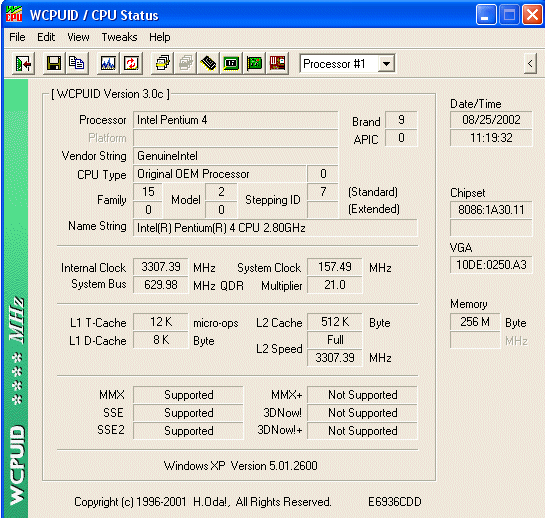System Setup and Benchmarking
- Intel Pentium 4 2800MHz S478 Northwood CPU (21x133FSB)
- ABIT IT7-MAX I845E run in DDR354 mode (3:4 CPUFSB: Memory ratio)
- 256MB Corsair XMS3200 C2 RAM (run at 2-5-2-2 timings at 178MHz and 2-6-3-3 timings at 210MHz)
- Alpha 8942T cooler with 80mm Panaflo Hi fan
Comparative Setup
-
AMD XP2600+ S462 CPU (12.5x170FSB) (enhanced for this suite of benchmarks)
-
256MB Samsung PC2700 RAM (run at strictest timings, 170MHz)
-
ABIT KX7 333-RAID
Common components
- Leadtek GeForce4 Ti 4600 128MB at stock speeds (300/648)
- 120GB Western Digital 120JB 7200rpm hard drive with 8MB cache.
- Liteon 16x DVD
- Pioneer 104 DVD-R
- Soundblaster Audigy
- Samcheer 420w PSU
- 21" Sony G500 FD monitor
Software
- Windows XP Professional Build 2600.xpclient.010817-1148
- Intel Application Accelerator drivers
- VIA 4-in-1s
- Detonator XP 30.30 drivers
- Sisoft Sandra 2002 Professional Service Pack 1
- Pifast v41
- Lame v3.91 MP3 encoding with Razor-Lame 1.15 front-end
- PCMark 2002
- Ocuk SETI Benchmark
- 3DMark 2001SE
- Comanche 4 benchmark
- Serious Sam 2 Valley of the Jaguar Timedemo
- Quake 3 v1.30
A few things to note before we benchmark this processor. We've already reviewed the AMD XP2600+ processor here at Hexus. We found its performance to be roughly comparable to a Pentium 4 running at 2.53GHz. With that being the case, we already know that it will most likely lose most benchmarks to the faster Pentium 4 2.8GHz CPU.
What would be interesting, however, would be to compare the XP2600+ against the P4 2.8GHz if the Athlon was running a faster front-side-bus. It was obvious from our review that the XP was being held back in performance stakes by it meagre 133FSB. What if it was run at (or close to) its forthcoming 166 FSB. So, to make things far more spicy, I've decided to run it at 2125MHz with a 170FSB. Perhaps should have been the real XP2600. A 12.5x multiplier and 170MHz FSB should push up its scores in memory-dependant benchmarks.
Both platforms are using DDR memory. The Intel P4 is running memory asynchronously to its 133FSB. Using an ABIT IT7-MAX, I'm able to run the memory at a 3:4 ratio, i.e 178MHz. The Athlon is running its memory at our manufactured 170FSB. Not only do we have parity with our chosen memory technologies (DDR), we almost have parity in our memory speeds. This should give us an indication of just how they perform with fast system memory. I've chosen to benchmark with DDR over RAMBUS simply due the fact that the majority of users use DDR-equipped motherboards.
Overclocking
We always like to see just how far we can push our components here at Hexus. I've already noted that this processor arrives with a stock voltage of 1.525v. Considering that we have a stock speed of 2.8GHz, I wanted to see just how much headroom the present Northwood core has.
Raising the FSB in 3MHz (63MHz clock speed) increments, and using Prime95 as a basic gauge of stability, 2900MHz came and went at default voltage. What was more pleasing was that 3GHz was seen off with no voltage increase at all. The first errors presented themselves at a lofty 3.14GHz. Plans to release a 3.06GHz soon may not be as far-fetched as you may imagine. Raising the voltage to 1.7v in BIOS, which resulted in a load voltage of 1.61v, I gained rock-solid stability at 3307MHz / 157FSB. The processor does go higher, but then heat becomes the enemy for us air-cooled users. Using an Alpha 8942T and Panaflo Hi 80mm fan, I ran SETI over a weekend without issue at between 3260MHz and 3320Mhz. Load temperatures hovered between 52 - 57c depending upon the application used and ambient temperatures. Here's a quick WCPUID shot detailing our overclock.

Not too shabby, eh ?. These Northwoods still have some life left in them yet. I'll be including a full set of overclocked results in this review. Please remember that your overclocking mileage will vary considerably. Having said that, 3307MHz, with 1.6v load voltage, is impressive in its own right.









